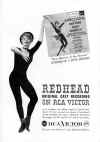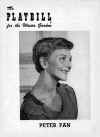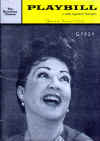History of The Musical Stage
1950s Part IV: The Great Dames
by John Kenrick
(Copyright 1996; revised 2014)
(The images below are thumbnails – click on them to see larger versions.)
Many of the most popular musicals of the 1950s were tailored for specific leading ladies. In fact, Broadway's leading ladies of this period arguably had a greater effect on the development of new stage musicals than performers have at any time before or since.
Gwen Verdon: "Aces in All The Right Places"
 Gwen
Verdon struts her stuff in an ad for the original cast
recording of Redhead (1959).
Gwen
Verdon struts her stuff in an ad for the original cast
recording of Redhead (1959).
Can Can (1953 - 892 performances) and Damn Yankees (1955 - 1,019 performances) brought Gwen Verdon two Tony Awards, as well as an extraordinary professional and personal partnership with Damn Yankees choreographer Bob Fosse. Verdon proved she was far more than a dancer in New Girl In Town (1957 - 431 performances), a musical comedy based on Eugene O'Neill's powerful drama Anna Christie. Some critics complained that the libretto prettified the darker aspects of the story, and none of the songs made the pop charts, but composer/lyricist Bob Merrill's score made O'Neill's bitter dockside characters sing with surprising heart. Playing a prostitute discovering real love, Verdon won her third acting Tony, sharing a rare tie award with co-star Thelma Ritter, who delighted audiences as the scruffy wharf doyenne Marthy. Fosse's sensuous choreography gave New Girl in Town a much needed edge, but he felt restricted by George Abbott's conservative direction. After a major disagreements, including the deletion of a bawdy whore house ballet, Fosse decided to be both director and choreographer for all his future projects.
Redhead (1959 - 452 performances), the tale of a 1907 London girl who helps her boyfriend catch a Jack the Ripper-type serial killer, was a so-so show that relied heavily on Verdon's charms and Fosse's sensational choreography. The dances included "The Uncle Sam Rag" and "The Pickpocket Tango." Redhead picked up Tony Awards for best musical, actress and choreography, among others. With Verdon's first four Broadway roles, she had become the first performer ever to win four Tonys -- an accomplishment very few have matched since that time. Fosse and Verdon took their relationship a step further, secretly marrying soon after Redhead opened.
Verdon and Fosse triumphed again with Sweet Charity (1966 - 608 performances), the touching story of a taxi-dancer who refuses to stop believing in love. Her limber, jubilant renditions of "If They Could See Me Now" and "I'm a Brass Band" became the stuff of theatrical legend. More than a decade later, Verdon co-starred with Chita Rivera and Jerry Orbach in Chicago (1975 - 898 performances), a cynical vaudeville-format tale of murder and legal huckstering in the 1920s. Its difficult pre-Broadway tour nearly killed director-choreographer Fosse, who suffered a heart attack. Overshadowed by the massive acclaim for A Chorus Line, this innovative masterpiece did not get its full due until more than 20 years later, when it would become the longest running revival in theatrical history.
With a career consisting of just six Broadway musicals (five choreographed by Fosse), Gwen Verdon garnered four Tonys and became one of the greatest stars of the Broadway musical's so-called "golden age." In later years, she appeared in various films and television projects, leaving a gap no other stage performer could fill. Professional revivals of New Girl In Town or Redhead are unthinkable without Verdon providing her unique innocent sensuality. Maybe someday a star with similar qualities will come along, but if so it will be a great surprise.
Mary Martin: "Do You Believe?"
 Mary
Martin as Peter Pan. She and her her co-star Cyril
Ritchard both earned Tonys and starred in three televised versions of this enchanting
Jerome Robbins production.
Mary
Martin as Peter Pan. She and her her co-star Cyril
Ritchard both earned Tonys and starred in three televised versions of this enchanting
Jerome Robbins production.
From the moment Mary Martin stole Leave It To Me (1938 - 291 performances) by singing Cole Porter's "My Heart Belongs To Daddy," this previously unknown girl from Weatherford, Texas was a Broadway star. Throughout the 1930s and 40s she starred in a succession of stage musicals, culminating in her creating the role of Nellie Forbush in South Pacific. The 1950s brought her two more landmark roles.
Los Angeles-based producer Edwin Lester secured the American rights to James Barrie's Peter Pan and reconceived it as a musical for Martin. (Because of the flying apparatus used at the time, it was physically necessary to cast women as Peter.) Despite having Cyril Ritchard as a comically effete Captain Hook, staging by Jerome Robbins, and a Carolyn Leigh-Moose Charlap score that included "I'm Flying" and "I Won't Grow Up," more was needed. Lyricists Betty Comden and Adolph Green joined composer Jule Styne to add "Neverland," "Hook's Waltz" and several other numbers that showcased the two stars. Martin and Ritchard gave their all, and Peter Pan (1954 - 152 performances) became a critically acclaimed hit.
The sold-out Broadway run of Peter Pan was cut short so that NBC could broadcast the show as a live event in 1954, drawing such massive ratings that the cast reunited for a second live broadcast two years later. Thanks to continued public demand, Martin and Ritchard reunited to videotape the show in 1960. This color version was re-run several times through the early 1970s, becoming a lasting favorite. Hidden away for years due to legal complications, it was released on home video in 1989, becoming an instant collectable. Martin often said Peter was her favorite role. Sandy Duncan (whose 1979 production became the longest running Peter Pan of all time) and Cathy Rigby have revived this entertaining musical with great success, but Martin's performance in the classic video has remained a favorite with several generations of fans.
Rodgers and Hammerstein's The Sound of Music (1959 - 1,443 performances) was based on the real-life story of the Von Trapp Family Singers, who left Austria in the 1930s to escape Nazi persecution. Dismissed as sentimental operetta by many critics, the show thrived thanks to a superb score and Martin's deft portrayal of Maria. Although twice the character's age, she captivated audiences – even when the unexpected happened. During flying rehearsals for the video version of Peter Pan, handlers lost control of the equipment and Martin hit a brick wall. Her arm was broken, but she was unwilling to miss a single performance of Sound of Music. She performed in slings created by designer Mainbocher to match his costumes. When Martin recovered and resumed rehearsals for Peter, she found that stagehands had nailed a mattress to the site of her accident with a sign that read, MARY MARTIN SLAPPED HERE.
After the disappointing Jenny (1963 - 82 performances), Martin starred in Hello Dolly on tour and in London before teaming with Robert Preston in the acclaimed two character marital study I Do! I Do (1966 - 560 performances). She then retired from the musical stage. After the death of her longtime husband Richard Halliday, Martin appeared in the stage comedies Do You Turn Somersaults and Legends, and had her own talk show on PBS.
Martin's fame as a musical theatre legend proved lasting. Her son, Larry Hagman, loved to tell of a visit to Las Vegas in the 1980s, when his TV series Dallas at the height of its popularity. People initially recognized him but not his mother. "Oh well," he quipped, "that's show biz, Mamma." When they attended longtime friend Joel Grey's act, Grey introduced Hagman from the stage, to warm applause. Grey then said, "And here is Larry's mother, who you all know as Peter Pan, the incomparable Mary . . ." and before hearing her last name, the audience leapt to its feet cheering. When the prolonged outburst died down several minutes later, Martin whispered in her son's ear with a native Texan drawl, "And that's showbiz too, honey!" When she died in 1990, newscasts and headlines carried images of this beloved actress -- in full flight as Peter Pan.
Ethel Merman: "Stand the World on Its Ear"
 A jubilant Ethel Merman on the original Playbill cover for
Gypsy.
A jubilant Ethel Merman on the original Playbill cover for
Gypsy.
Ethel Merman was the golden age Broadway musical personified, the genre's brightest, boldest star for most of the 20th Century. Her brash personality and booming voice made her a target for parody, but that is to be expected when someone is one of a kind. While Call Me Madam (1950 - 644 performances) had an outstanding Irving Berlin score, Merman was the key to its success. A rights dispute kept her off the cast album, where she was replaced by pop singer Dinah Shore. Merman's separate recording of the score sold far more copies. To the public, there was no Madam without Ethel. After filming Madam in 1953, Merman retired to devote time to her third husband in Denver. When the marriage failed (Merman a Denver housewife?) she was coaxed back to Broadway for Happy Hunting (1956 - 508 performances). Thanks to "The Merm," the charming "Mutual Admiration Society" became a hit tune, and the mediocre show managed a profitable run.
Oscar Hammerstein II convinced protégé Stephen Sondheim to collaborate as lyricist with composer Jule Styne on a vehicle for Merman. Gypsy (1959 - 702 performances) was based on the memoirs of famed burlesque stripper Gypsy Rose Lee, but the exquisite Arthur Laurents libretto focused on Gypsy's showbiz-obsessed mother, Rose Hovick. Styne and Sondheim wrote what is now recognized a classic score, including "Everything's Coming Up Roses," "Let Me Entertain You," "Together Wherever We Go" and the searing "Rose's Turn." ("Here she is boys! Here she is world! Here's Rose!!") Merman took a gamble and played Rose as a full-fledged monster, receiving the best reviews of her career. The ultimate musical comedienne proved she could be an actress of devastating power.
Acclaimed as a masterpiece today, Gypsy's score and book were not even nominated for Tony Awards. Adding insult to injury, Merman lost the Best Actress award to Sound of Music's Mary Martin. Merman bore no grudges. Her affectionate professional assessment of longtime friend Martin: "She's okay, if you like talent."
After scoring a personal triumph with a 1966 revival of Annie Get Your Gun, Merman took over the lead in the long-running original production of Hello Dolly, a show which had been originally conceived for her. She extended her stay, helping Dolly become the longest running Broadway musical up to that time. Thereafter, Merman limited herself to concert and television appearances, claiming that the lifestyle required during a Broadway run was "like taking the veil." (For more, see our special feature Merman 101.)
Shooting Stars
 With
only one hit musical, Judy Holliday was one
of Broadway's most beloved stars – seen here as she appeared on the original
cast Playbill for Bells Are Ringing (1956).
With
only one hit musical, Judy Holliday was one
of Broadway's most beloved stars – seen here as she appeared on the original
cast Playbill for Bells Are Ringing (1956).
Even in an age of many new musicals, relatively few Broadway performers had the good luck to originate more than one memorable role. Several leading ladies of this period had spectacular but surprisingly brief reigns as Broadway stars. A short list would have to include:
- Judy Holliday was
primarily known as a comic actress until her musical triumph in
Bells Are Ringing (1956 - 924 performances). The ill-fated Hot Spot
(1963) was her only other stage musical.
- Dolores Gray had
fine looks and a socko voice, won a Tony in the flop Carnival in Flanders
(1953 - 6 performances) and co-starred with Andy Griffith in Destry Rides Again
(1959 - 473 performances). But she went off to a few decades of stardom
in London, and was nearly forgotten by the time she toured the USA in
42nd Street in the 1980s.
- Vivian Blaine (1921-1995) knocked Broadway
for a loop as the original Miss Adelaide in Guys and Dolls,
but Say Darling (1958 - 332 performances) was her only other original musical vehicle. Her
last assignment was as a vacation replacement for Lila Kedrova in the revival of
Zorba (1983).
- Isabel Bigley (1926-2006), Ms.
Blaine's acclaimed Tony-winning Guys and Dolls co-star, didn't do much better,
disappearing after Me and Juliet (1953 - 358 performances).
- The vibrant Nanette Fabray showed
great promise in High Button Shoes (1947 - 727 performances), but the brief runs of Arms
and The Girl (1950 - 134 performances) and Make a Wish (1951 - 102 performances) drove her
into television and film. After returning to Broadway in the poorly received Mr. President (1962 - 265
performances), she turned down the title role in Hello Dolly.
- Shirley Booth's
child-like voice and disarming way with a comic line wowed audiences and critics alike
in A Tree Grows in Brooklyn (1951 - 270 performances) and By The Beautiful Sea (1954
- 270 performances), but after the failure of Juno (1959 - 16 performances) she settled in as
television's Hazel. She appeared in a few plays, but after the disastrous
Look to the Lillies (1970 - 25 performances) and a short-lived revival of Noel Coward's
comedy Hay Fever, Booth disappeared into a prolonged retirement.
- Carol Lawrence made
theatrical history as the original Maria in West Side Story, but the
failure of Saratoga (1959 - 80 performances) and Subways Are for Sleeping (1961 -
205 performances) left her playing Las Vegas, television and summer
theatres, returning to Broadway only as an occasional replacement.
Why were these talented women unable to find lasting stardom at a time when others flourished? Part of the answer lies in the inscrutable fluctuations of public taste, part in the equally inscrutable effect of timing -- or what some in the theatrical profession call "fate." The special qualities that made Judy Holliday the perfect "Ella" or Carol Lawrence the perfect "Maria" made them hard to place in other leading parts, while Merman and Martin could both play a wide variety of characters. On the two occasions when these two actresses took on the same star role (Annie Oakley and Dolly Levi), both gave those characters unique personal interpretations, winning equal acclaim.
The Broadway musical was thriving at the end of the 1950s, but rock and roll was changing the tastes of the Western world. From here on, Broadway's story takes a somewhat rockier path. But as Rose advises in Gypsy, "You gotta take the rough with the smooth, baby . . ."
